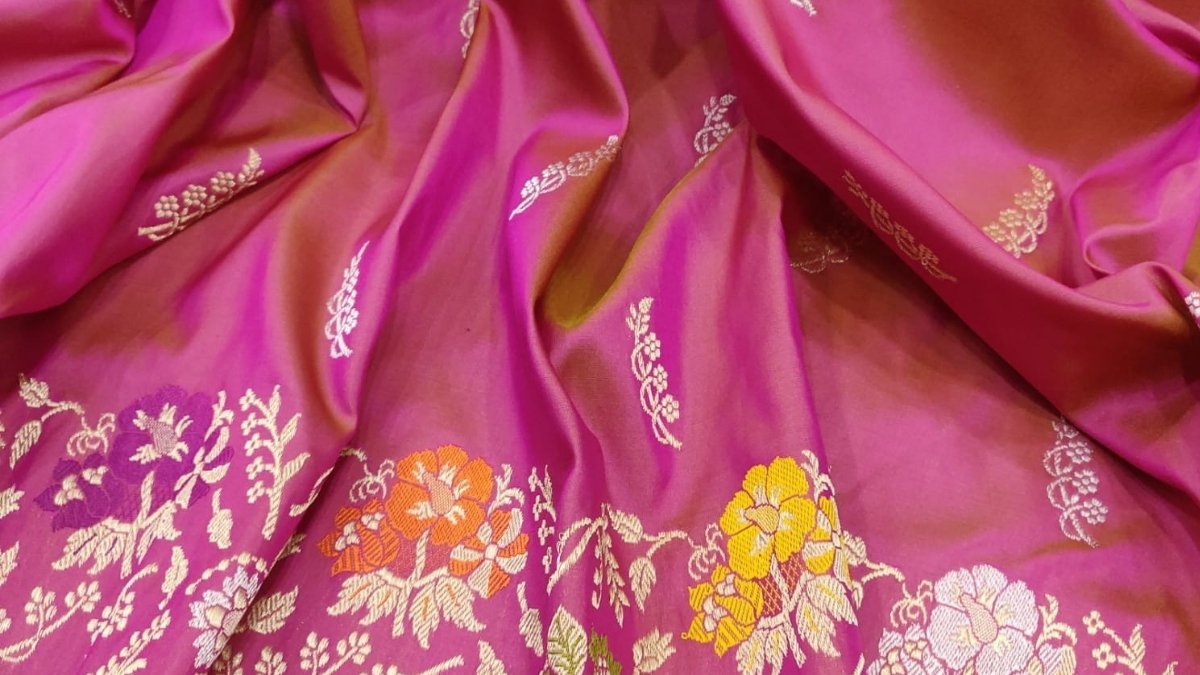
The Kathan saree, often confused with “Katan,” originates from the culturally rich city of Varanasi (Banaras), Uttar Pradesh. The term Kathan refers to a type of pure silk yarn that is tightly twisted, resulting in a fine and durable fabric. This weaving technique dates back to the Mughal era, when royal patronage led to the flourishing of luxurious silk textiles. During this time, Persian weaving techniques were combined with Indian artistry, giving birth to the iconic Kathan silk fabric that we see today.
Kathan Silk Weaving Techniques: Twisted Yarn Craftsmanship
Kathan silk is distinct because of its two-ply twisted silk yarn, which is woven into the warp and weft of the fabric. This makes the fabric sturdier and glossier than regular silk sarees. The yarns are reeled from mulberry silkworm cocoons, and the twisting process is entirely manual or semi-mechanized, depending on the artisan’s tradition. These sarees are typically handwoven on pit looms by skilled weavers from Varanasi’s famed weaving families, making each saree a reflection of inherited craftsmanship.
Fabric Composition of Kathan Saree: Pure Silk vs Blended Varieties
Traditional Kathan sarees are made from 100% pure mulberry silk, making them high-end luxury garments. However, modern variations have introduced Kathan silk blends, such as Kathan Georgette and Kathan Cotton-Silk, to make the sarees lighter and more affordable. Pure Kathan silk sarees are known for their natural sheen, firmness, and fluid drape, while blended versions are softer and more flexible, suitable for regular wear or casual festive occasions.
Intricate Motifs and Zari Work in Kathan Sarees: Mughal-Inspired Patterns
Kathan sarees are renowned for their elaborate motifs and brocade zari work. These include traditional designs like kalga, bel, jhallar, paisleys, and floral jaals, often drawn from Mughal architecture and Persian aesthetics. The zari (gold or silver thread) used is either real metallic yarn or tested zari, depending on the price and quality. The placement of these motifs is often symmetric and balanced, especially in Kathan Banarasi sarees, which emphasize grandeur and intricacy.
Differences Between Kathan Saree and Banarasi Saree: A Common Confusion
Though often interchanged, Kathan saree is a type of Banarasi saree. While Banarasi saree refers to any saree woven in Banaras using traditional techniques, Kathan saree specifically refers to Banarasi sarees made from twisted pure silk yarn. Not all Banarasi sarees are Kathan; some are made from Shattir, Georgette, or Organza. Kathan sarees stand out for their denser weave and richer texture, making them a premium segment of the Banarasi category.
Modern Variations of Kathan Sarees: Lightweight and Designer Fusions
In recent years, Kathan sarees have undergone significant modernization. Designers now create Kathan tissue sarees, Kathan Tussar silk sarees, and digitally printed Kathan sarees. These retain the essence of traditional weaving but add contemporary aesthetics, making them more appealing to younger audiences and bridal buyers. Lightweight versions are preferred for pre-wedding functions, while heavily brocaded Kathan sarees remain popular for bridal trousseaus.
Styling Guide for Kathan Saree: Draping and Accessory Suggestions
The rigid yet fluid texture of Kathan silk makes it ideal for structured drapes like nivi or lehenga-style sarees. Pair a Kathan saree with traditional gold jewelry or meenakari sets to highlight the regal aura. For a contemporary look, combine it with statement blouses—like halter necks or puff sleeves—crafted from velvet or brocade. Footwear should complement the grandeur—opt for mojris or embellished block heels. Clutches in silk or metallic finishes round off the look perfectly.
Care Instructions for Kathan Sarees: Maintenance and Storage Tips
Due to the delicate nature of silk and zari, Kathan sarees must be dry-cleaned only. Avoid folding along the zari line to prevent breakage. When not in use, store in muslin cloth in a dry, cool place. It is advisable to air the saree occasionally and avoid direct sunlight to prevent fading. For long-term preservation, use silica gel packets to absorb moisture and prevent fungal growth.
The Kathan saree is a timeless embodiment of Indian textile excellence, combining history, artistry, and elegance in every thread. Whether you’re a bride, a saree enthusiast, or someone exploring traditional Indian garments, understanding the nuances of the Kathan saree helps appreciate its true value and legacy.
